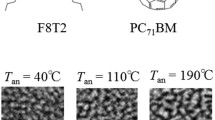Abstract
In the present work, the effects of processing conditions comprising poly(3-hexylthiophene-2,5-diyl):[6,6]-phenyl-C61-butyric acid methyl ester (P3HT:PCBM) ratio, P3HT concentration, co-solvent, thermal annealing, solvent annealing and the embedment of calcium as an exciton blocking layer on power conversion efficiency were studied. Polymer bulk heterojunction solar cells having a glass/ITO/PEDOT:PSS/P3HT:PCBM/(Ca)/Al sequence were fabricated. The main purpose of this work was to investigate the most effective parameters influencing the performance of polymer solar cells all in one study. Among these parameters, the role of high boiling point co-solvent such as N-Methyl-2-pyrrolidone, dimethyl sulfoxide and diiodooctane were emphasized. The morphology of the active layer was investigated using atomic force microscopy and field emission scanning electron microscopy (FESEM). The utilization of dimethyl sulfoxide as a co-solvent (5 %) led to larger heights on the surface whereas the solvent annealing reduced them and this sequence can disturb the size and distribution of PCBM domains. Incorporating diiodooctane as a co-solvent increased the short circuit current about three orders of magnitude. FESEM images showed a fibrillar structure for P3HT phase with approximately 25 nm in diameter and up to 250 nm in length. The presence of a thin Ca layer exhibited a significant effect on all I–V parameters, particularly on the fill factor.















Similar content being viewed by others
References
Y. Xia, R.H. Friend, Macromolecules 38, 6466 (2005)
F.C. Krebs, S.A. Gevorgyan, J. Alstrup, J. Mater. Chem. 19, 5442 (2009)
C.J. Brabec, N.S. Sariciftci, J.C. Hummelen, Adv. Funct. Mater. 11, 15 (2001)
C.J. Brabec, Sol Energy Mater Sol C 83, 273 (2004)
F. Padinger, R.S. Rittberger, N.S. Sariciftci, Adv. Funct. Mater. 13, 1 (2003)
S.E. Shaheen et al., Appl. Phys. Lett. 78, 841 (2001)
N.S. Sariciftci et al., Science 258, 1474 (1992)
G. Yu et al., Science 270, 1789 (1995)
H. Hoppe, N.S. Sariciftci, Adv. Polym. Sci. 214, 1 (2008)
A.C. Arango et al., Adv. Mater. 12, 1689 (2000)
J. Piris et al., J. Phys. Chem. C 113, 14500 (2009)
A.J. Moul, K. Meerholz, Adv. Mater. 20, 240 (2008)
C.J. Brabec et al., Adv. Mater. 22, 3839 (2010)
H. Hoppe, N.S. Sariciftci, J. Mater. Chem. 16, 45 (2006)
J.A. Gratt, R.E. Cohen, J. Appl. Polym. Sci. 91, 3362 (2004)
G. Li et al., Nature Mater 4, 864 (2005)
J.K. Lee et al., J. Am. Chem. Soc. 130, 3619 (2008)
W. Li et al., Polymer 51, 3031 (2010)
Q. Hou et al., J. Mater. Sci.: Mater. Electron. 24, 4284 (2013)
X. Li et al., J. Mater. Sci.: Mater. Electron. 25, 140 (2014)
Q. Hou et al., J. Mater. Sci.: Mater. Electron. 24, 536 (2013)
N.S. Sabri et al., J. Mater. Sci.: Mater. Electron. 24, 2183 (2013)
P.E. Shaw, A. Ruseckas, I.D.W. Samuel, Adv. Mater. 20, 3516 (2008)
H. Wang et al., Nanoscale 3, 2280 (2011)
M.C. Heiber, A. Dhinojwala, J. Phys. Chem. C 117, 21627 (2013)
Acknowledgments
The authors appreciate the Iran National Science Foundation for their financial support under Project No. 89002375.
Author information
Authors and Affiliations
Corresponding author
Rights and permissions
About this article
Cite this article
Nasiri, M., Abbasi, F. Relationships between processing conditions, morphology, and I–V characteristics in P3HT:PCBM solar cells. J Mater Sci: Mater Electron 26, 2639–2646 (2015). https://doi.org/10.1007/s10854-015-2738-4
Received:
Accepted:
Published:
Issue Date:
DOI: https://doi.org/10.1007/s10854-015-2738-4




